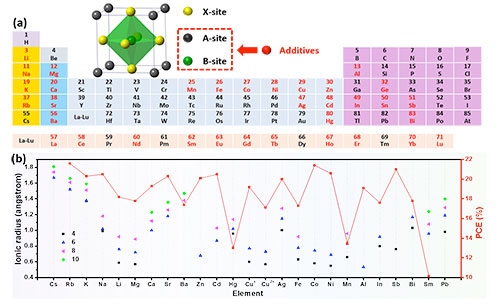| Jul 22, 2019 | |
The role of metal cations in perovskite solar cells(Nanowerk News) Metal halide perovskites have sparked enormous research attentions due to their exceptional virtues involving high extinction coefficient, tunable band gap, long carrier diffusion length, low exciton binding energy. Such appealing properties render perovskites as a near-perfect photo-absorber and stimulate the development of perovskite solar cells. |
|
| Additive engineering has been developed to optimize perovskite quality. All inorganic devices are becoming increasingly prominent according to the requirement of long-term stability. Consequently, inorganic additives of metal cations are more attractive because most of them can enter the bulk phase or adsorb/exchange at the surface to tune the photoelectrical properties. | |
 |
|
| (a) Schematic of the ABX3 perovskite crystal structure and the elements that have been used in perovskites; (b) The ionic radius of various cations under different coordination numbers and the highest efficiency of the PVSCs with metal cation additives. (Image by WANG Kai and DUAN Lianjie) | |
| Prof. LIU Shengzhong’s group from the Dalian Institute of Chemical Physics (DICP) of the Chinese Academy of Sciences (CAS) achieved a series of innovations in perovskite solar cells. Recently, his group was invited to discuss the role of metal cations in perovskite solar cells (Advanced Materials, "Metal Cations in Efficient Perovskite Solar Cells: Progress and Perspective"). | |
| The scientists discussed the metal cations for perovskite solar cells by focusing on the position of the cations in perovskites, the modulation of the film quality, and the influence on the photovoltaic performance. Metal cations were considered in the order of alkali cations, alkaline earth cations, then metal cations in the ds and d regions, and ultimately trivalent cations (p- and f-block metal cations) according to the periodic table of elements. | |
| In addition, the effects of metal cations on the perovskite tolerability, film morphology, charge dynamics, crystal strain effect and stability were discussed systematically. Finally, the scientists highlighted the opportunities and challenges of metal cations in perovskite solar cells. |
| Source: Chinese Academy of Sciences | |
|
Subscribe to a free copy of one of our daily Nanowerk Newsletter Email Digests with a compilation of all of the day's news. |
